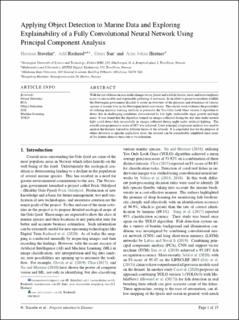| dc.contributor.author | Stavelin, Peter Herman | |
| dc.contributor.author | Rasheed, Adil | |
| dc.contributor.author | San, Omer | |
| dc.contributor.author | Hestnes, Arne Johan | |
| dc.date.accessioned | 2022-08-26T17:11:47Z | |
| dc.date.available | 2022-08-26T17:11:47Z | |
| dc.date.created | 2021-02-21T10:51:00Z | |
| dc.date.issued | 2021 | |
| dc.identifier.citation | Ecological Informatics. 2021, 62, 101269. | en_US |
| dc.identifier.issn | 1574-9541 | |
| dc.identifier.uri | https://hdl.handle.net/11250/3013912 | |
| dc.description.abstract | With the rise of focus on man made changes to our planet and wildlife therein, more and more emphasis is put on sustainable and responsible gathering of resources. In an effort to preserve maritime wildlife the Norwegian government decided to create an overview of the presence and abundance of various species of marine lives in the Norwegian fjords and oceans. The current work evaluates the possibility of utilizing machine learning methods in particular the You Only Look Once version 3 algorithm to detect fish in challenging conditions characterized by low light, undesirable algae growth and high noise. It was found that the algorithm trained on images collected during the day time under natural light could detect fish successfully in images collected during night under artificial lighting. The overall average precision score of 88% was achieved. Later principal component analysis was used to analyze the features learned in different layers of the network. It is concluded that for the purpose of object detection in specific application areas, the network can be considerably simplified since many of the feature detector turns our to be redundant. | en_US |
| dc.language.iso | eng | en_US |
| dc.publisher | Elsevier | en_US |
| dc.subject | Neural networks | en_US |
| dc.subject | PCA | en_US |
| dc.subject | Object detection | en_US |
| dc.subject | XAI | en_US |
| dc.subject | Machine learning | en_US |
| dc.subject | YOLO | en_US |
| dc.title | Applying Object Detection to Marine Data and Exploring Explainability of a Fully Convolutional Neural Network Using Principal Component Analysis | en_US |
| dc.type | Peer reviewed | en_US |
| dc.type | Journal article | en_US |
| dc.description.version | acceptedVersion | en_US |
| dc.source.volume | 62 | en_US |
| dc.source.journal | Ecological Informatics | en_US |
| dc.identifier.doi | 10.1016/j.ecoinf.2021.101269 | |
| dc.identifier.cristin | 1892066 | |
| dc.source.articlenumber | 101269 | en_US |
| cristin.ispublished | true | |
| cristin.fulltext | postprint | |
| cristin.qualitycode | 1 | |
